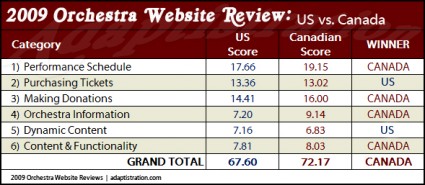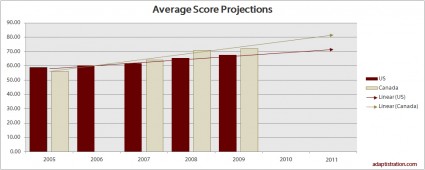The final article in the 2009 Orchestra Website Reviews will compare and contrast US and Canadian results. Both groups made advancements but the Canadians, on average, once again made greater strides. This article examines exactly which components had the most impact on these developments…
Category By Category Comparisons
The differences between US and Canadian average category score strengths and weaknesses were similar the 2008 results. Ultimately, Canadian orchestras managed to win four out of six categories and US orchestras captured two. The following table breaks down the results:
Compared to 2008, the difference in category scores were a bit closer, but the average Canadian orchestra did a much better job at presenting concert information along with providing institutional information. Of particular note is the Symphony Nova Scotia, which offered contact information for each board member, something no other orchestra managed to accomplish. Overall, most Canadian orchestras gained an advantage in the Performance Schedule category by offering interactive monthly calendars on the homepage, which is one sub category where US orchestras dropped a bit.
 When it came to assisting patrons with purchasing tickets, US orchestras did a much better job at providing options for online subscription and single ticket purchases whereas both groups offered similar levels of telephone based support and seating chart offerings.
When it came to assisting patrons with purchasing tickets, US orchestras did a much better job at providing options for online subscription and single ticket purchases whereas both groups offered similar levels of telephone based support and seating chart offerings.
The only category where US orchestras not only dominated but increased at a faster rate of improvement over their Canadian counterparts is in Dynamic Content. By and large, US orchestras offered a higher quantity and quality of social networking offerings. At the same time, a larger percentage of Canadian orchestras offered RSS feeds for press materials and/or concert events but this wasn’t enough to offset gains made by their US counterparts.
Ultimately, US orchestras managed to reach higher highs and lower lows than the Canadians who did a better overall job at designing and implementing adequate website fundamentals. These are intriguing trends and it will be interesting to see if these trends continue into 2010/11 review season.
Projections
If past performance is any indicator of future returns, then things are looking up. If scores continue to increase at historic rates, then the average Canadian orchestra stands a very good chance at coming close to or exceeding a minimum acceptable score for an effective website by the 2011 review.
Nonetheless, if any orchestra is interested in improving their score in the 2010 review, they would be wise to focus on the following:
- Offer online subscription purchases/renewals.
- Offer dynamic seating charts with views of the stage (please, no more top down drawings).
- Increase the variety of online giving options.
- Improve the amount of biographical contact information for musicians, administrators, and board members.
- Include copies of the latest annual report and institutional transparency document.
- Offer RSS feeds for concert events.
- Include detailed press contact information.
The North American Top 10
Although the highest scoring Canadian orchestra dropped a slot from last year’s review, they made inroads by adding a third orchestra to the list. Nonetheless, the top three slots are occupied by the only two orchestra websites to break 90/100 for the past three years, Nashville Symphony and Chicago Symphony, as well as the steadily improving Saint Louis Symphony website.
For the most part, all of this year’s returning orchestras ended up in similar positions but the three bottom slots are occupied by newcomers Atlanta Symphony, Seattle Symphony, and Symphony Nova Scotia. The former two increased notable amounts in this year’s review while symphony Nova Scotia kept the same rank, but improved their overall score.
In the end, Canadian websites showed marked improvement and demonstrated that budget size places no undue burden on creating an effective website. It will be interesting to see what 2010 produces; will the Canadians manage to break the 90/100 threshold or will their US counterparts make a move to reclaim lost ground on the North American Top 10. Regardless, so long as scores continue to improve, the real winners are patrons who benefit from improved online offerings.





